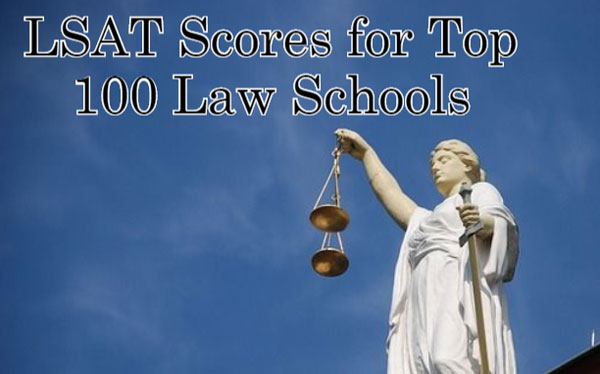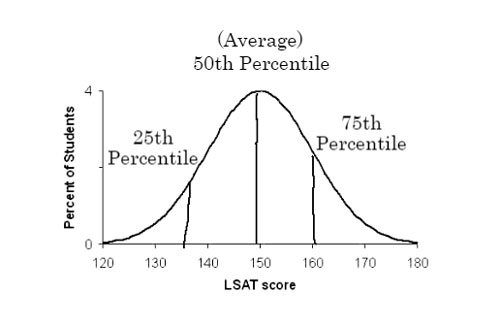Average LSAT Scores - New LSAT Score Ranges Chart, Good LSAT Score for College Admissions & Validity Period of LSAT Score
About LSAT: LSAT stands for Law School Admissions Test conducted by on behalf of Law School Admission Council (LSAC) for the admissions of various law courses includes BA, LLB, B.Sc, LLB and B.Com LLB. LSAT Exam is an integral part of the law school admission process in the US, Canada, and Other Countries. Every year officials conducts the law entrance for admission to USA (United States). The L.S.A.T Exam 2017-18 consists of 4 sections i.e. Evidence-Based Reading, Analytical and Logical Reasoning. There is also an optional essay section. The LSAT Scores from each section can range from 120 to 180.
LSAT 25th Percentile
If student score falls into a school’s 25th percentile range, it means that student LSAT score was better than that of 25% of recently admitted students.
LSAT 50th Percentile/Average LSAT Score
If student score is within a school’s 50th percentile, then you scored higher than 50% of recently enrolled students. You also scored lower than 50% of recently enrolled students.
LSAT 75th Percentile
If student LSAT score is in 75th percentile for a given law school, then it’s a good LSAT score. 75th percentile score means that you performed as well or better than 75% of the school’s newly admitted class, and chances of law admissions are very high.
Note:
LSAT Test Results 2017 will be reported within four weeks after the test date and will be available on candidate’s registration log-in. LSAT Score card will be available for download pdf for 2 months from the date of announcement of LSAT Results.
Will soon we will update the when and how to get LSAT Test Scores 2017 -18 and your official LSAT Exam Score Report Release Details on this spot.
 |
| LSAT SCORES |
LSAT Score Range – 120 to 180
Lowest Possible LSAT Score – 120
Good LSAT Score – 180
Average LSAT Score – 150 Approximately
LSAT Scores:
The LSAT is scored on a scale of 120 to 180 points. The average LSAT score of the top 50 law schools is about 160, but if you’re looking to get into any one of the law schools, your score should be 150. According to LSAC (Law School Admission Council), exam takers will receive LSAT scores within 3 to 4 weeks after you take the Law School Admission Test (LSAT 2017-18). For reduce your tensions we provide Average LSAT Scores Ranges from here.LSAT Score Percentiles
 |
| LSATScorePercentileChart |
LSAT 25th Percentile
If student score falls into a school’s 25th percentile range, it means that student LSAT score was better than that of 25% of recently admitted students.
LSAT 50th Percentile/Average LSAT Score
If student score is within a school’s 50th percentile, then you scored higher than 50% of recently enrolled students. You also scored lower than 50% of recently enrolled students.
LSAT 75th Percentile
If student LSAT score is in 75th percentile for a given law school, then it’s a good LSAT score. 75th percentile score means that you performed as well or better than 75% of the school’s newly admitted class, and chances of law admissions are very high.
Note:
LSAT Test Results 2017 will be reported within four weeks after the test date and will be available on candidate’s registration log-in. LSAT Score card will be available for download pdf for 2 months from the date of announcement of LSAT Results.
Validity Period of LSAT Score:
According to official info, Law School Admissions Test (LSAT) Scores Validity period is 5 years.LSAT Scores for Top 100 Law Schools
| LSAT Score Range | Law School |
| 170 - 176 | Harvard University Law School |
| 170 - 175 | Columbia University Law School |
| 169 - 177 | Yale University Law School |
| 169 - 173 | New York University School of Law |
| 169 - 173 | University of Chicago Law School |
| 168 - 172 | Stanford University Law School |
| 166 - 172 | Northwestern University Law School |
| 166 - 171 | University of Pennsylvania Law School |
| 166 - 171 | University of Virginia School of Law |
| 166 - 170 | Georgetown University Law Center |
| 166 - 170 | University of Michigan Ann Arbor Law School |
| 166 - 168 | Cornell University Law School |
| 165 - 170 | Duke University School of Law |
| 165 - 167 | University of Southern California Gould School of Law |
| 164 - 170 | University of California Berkeley School of Law |
| 164 - 169 | University of California Los Angeles School of Law |
| 164 - 169 | Vanderbilt University Law School |
| 164 - 168 | University of Texas Austin School of Law |
| 164 - 166 | Emory University School of Law |
| 163 - 167 | University of Minnesota Twin Cities Law School |
| 163 - 166 | Boston University School of Law |
| 163 - 166 | University of Notre Dame Law School |
| 162 - 168 | George Washington University Law School |
| 162 - 168 | Washington University in St. Louis School of Law |
| 162 - 165 | Boston College Law School |
| 162 - 165 | Brooklyn Law School |
| 161 - 166 | Brigham Young University J. Reuben Clark Law School |
| 161 - 166 | Fordham University School of Law |
| 161 - 165 | University of California Hastings College of the Law |
| 160 - 167 | University of Illinois Urbana-Champaign College of Law |
| 160 - 166 | College of William and Mary Marshall-Wythe School of Law |
| 160 - 166 | Washington and Lee University School of Law |
| 160 - 165 | George Mason University School of Law |
| 160 - 165 | University of Colorado Boulder Law School |
| 160 - 165 | University of Maryland School of Law |
| 160 - 165 | Wake Forest University School of Law |
| 160 - 163 | Villanova University School of Law |
| 159 - 166 | University of Washington School of Law |
| 159 - 165 | Yeshiva University Benjamin N. Cardozo School of Law |
| 159 - 164 | Ohio State University Michael E. Moritz College of Law |
| 159 - 164 | Temple University James E. Beasley School of Law |
| 159 - 164 | University of Arizona James E. Rogers College of Law |
| 159 - 164 | University of Georgia Law School |
| 159 - 163 | American University Washington College of Law |
| 159 - 163 | Tulane University School of Law |
| 159 - 162 | University of Richmond T.C. Williams School of Law |
| 158 - 165 | University of Alabama School of Law |
| 158 - 164 | University of Iowa College of Law |
| 158 - 163 | Loyola Marymount University Law School |
| 158 - 163 | University of California Davis School of Law |
| 158 - 162 | Georgia State University College of Law |
| 158 - 162 | Pepperdine University School of Law |
| 158 - 162 | University of San Diego School of Law |
| 157 - 163 | Illinois Institute of Technology Chicago Kent College of Law |
| 157 - 163 | Lewis & Clark College North western School of Law |
| 157 - 163 | University of Houston Law Center |
| 157 - 163 | University of North Carolina Chapel Hill School of Law |
yes
ReplyDeleteWonderful information. First step to get into the law study is LSAT so people must prepare hard for it. Well, I already am going to complete my law study so now will have to take Bar exam. I was just wondering if you could provide some tips for Bar Exam Prep as well!
ReplyDelete